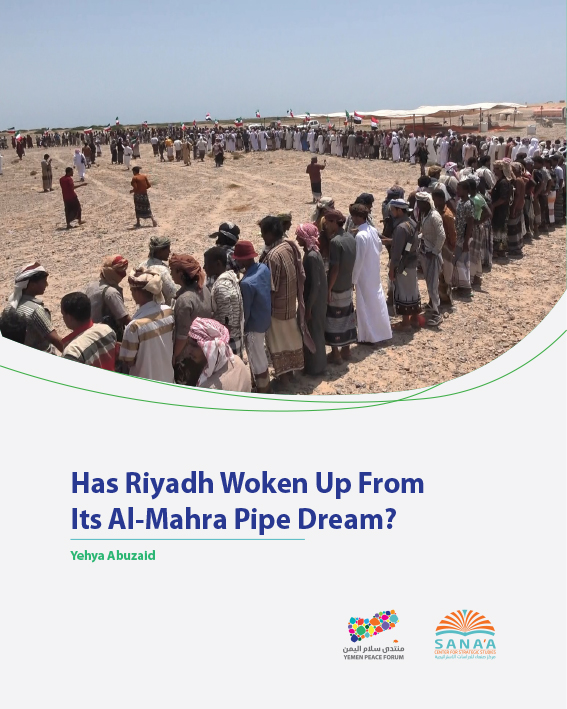Since 2017, many residents of Al-Mahra, Yemen’s easternmost governorate, have had a growing anxiety regarding their Saudi neighbors to the north. What began as a trickle of Saudi troops[1] into the area quickly transformed into what appeared to be a fully fledged campaign for control of the governorate, including its border with Oman to the east. By 2019, the Saudis had established more than 20 military bases and outposts across Al-Mahra, a governorate with no more than 300,000 inhabitants.[2] This deployment has fueled speculation from American[3] and Yemeni experts,[4] as well as Mahri locals,[5] that the reason for the Saudi presence was to secure Al-Mahra for the construction of a pipeline to carry Saudi crude oil to the Arabian Sea. The pipeline rumor has increased local resistance and inflamed tensions in the governorate between those who supported and opposed the Saudi presence.[6]
Then, at the beginning of November 2021, Saudi troops suddenly began withdrawing from positions in the governorate.[7] This was quickly followed by Omani Minister of Economy Said bin Mohammed al-Saqri calling for the revival of a decades-old proposal to construct a pipeline that would transport Saudi oil through Oman to the Arabian Sea.[8] While these events are ostensibly unconnected, many observers have been quick to connect the dots and see Saudi Arabia reorienting its pipeline dream fromAl-Mahra to the east.
Suspicion over Saudi Arabia’s intentions in Yemen’s east are nothing new. Some experts argue that Saudi Arabia has long desired access to the Arabian Sea via its neighbor to the south.[9] The strategic impetus is clear: It would end Saudi Arabia’s dependence on passage through the Strait of Hormuz, through which the majority of its oil exports pass and which might easily be threatened by Iran, the kingdom’s archrival across the Persian Gulf. This concern was evident during Saudi-Yemeni negotiations for an oil pipeline in the 1990s.[10] The negotiations eventually broke down over then-President Ali Abdullah Saleh’s fears of Saudi Arabia’s growing influence in the country.[11]
But Saudi interest in the pipeline did not end with the failed negotiations. According to a leaked American diplomatic cable from 2008, the Saudis remained keen to secure territory and build a pipeline by buying the loyalty of local leaders across the country.[12] Many continued to view the desire for an oil pipeline in Yemen as a key dimension of the Saudi-Yemeni relationship.
Suspicion regarding a pipeline through Yemen intensified when Saudi Arabia began entrenching itself in Al-Mahra in 2017. Aside from the many military installations Riyadh built in the governorate, Saudi Arabia recruited thousands of Mahris, putting them on its payroll in an apparent attempt to pacify antagonistic tribesmen and create its own irregular military force.[13] Additionally, the transfer of Mahri tribes residing in Saudi Arabia to Al-Mahra since 2017 created a base of support in the area.[14] Saudi construction firms have attempted to build infrastructure that many in the governorate thought was a precursor for a pipeline, leading to clashes between Mahri tribes and Saudi engineering crews.[15] Saudi forces also secured Nishtun port,[16] raising local suspicions that it was the intended site for an oil export terminal.
These suspicions were further fueled in 2018, by a memo leaked to local media in which a Saudi construction company, Huta Marine, thanked the Saudi ambassador to Yemen for commissioning a feasibility study for the construction of an oil port.[17] While neither Nishtun nor Al-Mahra were explicitly mentioned in the memo, the control of most of Yemen’s other viable ports by Houthi fighters and UAE-backed local forces was enough to drive speculation that the memo referred to Nishtun. The Middle East Monitor went so far as to use the memo and local fears to claim in a headline: “Saudi Arabia prepares to extend oil pipeline through Yemen to Arabian Sea.”[18]
While speculation regarding Riyadh’s pipeline ambitions has seemed plausible, it also merits some healthy skepticism. Saudi deployments and other tactics, such as transferring loyalist tribesmen, could represent a desire to counter Oman’s influence in Al-Mahra. It is no secret that there were tensions in the Saudi-Omani relationship, which only worsened once the Yemen war began. The Omanis, for their part, have leveraged various factors – including their native Mahri population, a targeted policy of granting residents of Al-Mahra Omani citizenship,[19] aid donations,[20] and maintaining close ties with Mahri political leaders, such as the prominent anti-Saudi figure Ali al-Hurayzi[21] – to push back against Saudi influence in the area. Publicly, the Saudis claim their troop deployments in Al-Mahra are focused on combating Houthi arms smuggling,[22] and indeed, the UN Panel of Experts on Yemen have accused the Omanis of facilitating Houthi smuggling efforts through the governorate.[23]
The theory that Riyadh was preparing to establish a pipeline in Al-Mahra seems implausible in light of Yemen’s entrenched political instability. Saudi Arabia’s ability to maneuver politically, economically and militarily in Yemen is significantly influenced by events outside of Al-Mahra, such as conflict with Houthis forces, tensions with Iran and Oman, and the reliability of the United States as an ally. Then there is the threat within the governorate from restive tribes who have a strong desire for autonomy, and even independence. If the Saudis were being practical about a potential oil pipeline, they would have to consider their ability, or lack of, to protect this immovable, multi-billion dollar asset.[24] Even before the uprising of 2011, a report by the Gulf Research Center, a Saudi think tank, concluded that Yemen was too volatile to consider a project to transport oil via a pipeline.[25] The Omani minister’s renewed call for a pipeline to transfer Saudi oil, coupled with an overall easing of tensions between Oman and Saudi Arabia since the ascension of Sultan Haithem, presents the Saudis with a more realistic, and less risky, prospect to the east.
The theory that Riyadh maintained a desire for a pipeline through Al-Mahra during the ongoing conflict was attractive to its supporters. Were Al-Mahra to be transformed from a peripheral, forgotten corner of Yemen into a key transit route for Saudi oil, it would have marked one of the most significant geopolitical shifts in the Yemen conflict. It would recast perceptions of the notoriously opaque Saudi strategic planning and redefined the war as one of conquest rather than regional rivalry and poor decision-making. Now, with Saudi-Omani relations appearing to have turned over a new leaf, we may never know what the kingdom’s ambitions were.
With warming relations between Riyadh and Muscat, Mahris might breathe a sigh of relief now that a significant threat to the relative stability they have enjoyed during the war has receded. This inclination may be premature. However Saudi intentions in Al-Mahra evolve, the Saudi policy of building tribal and military influence in the governorate puts them in a strong position to try and enforce their policy preferences. If the Yemeni war ends with the country’s fragmentation, whether officially or in practice, Riyadh could still pursue territorial ambitions in Al-Mahra to salvage something from their quagmire.
This report was produced as part of the Yemen Peace Forum, a Sana’a Center initiative that seeks to empower the next generation of Yemeni youth and civil society activists to engage in critical national issues.
The Sana’a Center for Strategic Studies is an independent think-tank that seeks to foster change through knowledge production with a focus on Yemen and the surrounding region. The Center’s publications and programs, offered in both Arabic and English, cover diplomatic, political, social, economic and security-related developments, aiming to impact policy locally, regionally, and internationally.
- Saleh Al-Mansoub, “The forces of the 137th Brigade hand over their positions at al-Ghaydah airport and a shipping port to the Arab coalition,” Alyemen Today (Filmmatters, November 15, 2017), https://www.alyementoday.com/314/105218-قوات–اللواء-137-تسلم–مواقعها–في–مطار–الغيضة–ومنفذ–شحن–للتحالف–العربي.
- Yahya al-Sewari, “Yemen’s Al-Mahra: From Isolation to the Eye of a Geopolitical Storm,” Sana’a Center For Strategic Studies, July 5, 2019, p. 24, https://sanaacenter.org/publications/analysis/7606.
- Bruce Riedel, senior fellow at Brookings, interviewed by the author, phone call, February 9, 2021.
- Ahmed Nagi, Nonresident Carnegie scholar at the Middle East Center, interviewed by author, Zoom, October 9, 2020.
- Yahya al-Sewari, “Yemen’s Al-Mahra: From Isolation to the Eye of a Geopolitical Storm,” Sana’a Center For Strategic Studies, July 5, 2019, p. 10, https://sanaacenter.org/publications/analysis/7606.
- Yahya al-Sewari, “Yemen’s Al-Mahra: From Isolation to the Eye of a Geopolitical Storm,” Sana’a Center For Strategic Studies, July 5, 2019, https://sanaacenter.org/publications/analysis/7606, p. 24.
- Elisabeth Kendall, “Locals Report That #Saudi Forces Stationed in #Mahra in East #Yemen Have Withdrawn from Several Positions around the Governorate (Desert and Coast) to Their Main Base at al-Ghayda Airport,” Tweet, @Dr_E_Kendall (blog), November 1, 2021, https://twitter.com/Dr_E_Kendall/status/1455167945383071747.
- Merza al-Khuwaldi, “Omani Minister to Asharq Al-Awsat: Time to Revive Transportation of Saudi Oil to Arabian Sea,” Asharq Al-Awsat, November 2, 2021 https://english.aawsat.com/home/article/3280971/omani-minister-asharq-al-awsat-time-revive-transportation-saudi-oil-arabian-sea
- Bruce Riedel, senior fellow at Brookings, interviewed by the author, phone call, February 9, 2021.
- Abdulghani Al-Iryani, senior researcher at the Sana’a Center for Strategic Studies, interviewed by author, Zoom call, February 1, 2020.
- Abdulghani Al-Iryani, senior researcher at the Sana’a Center for Strategic Studies,interviewed by author, Zoom call, February 1, 2020.
- “Yemen’s Big Brother: What Has Saudi Arabia Done for Yemen Lately?,” Wikileaks Public Library of US Diplomacy (Yemen Sana’a, June 18, 2008), https://wikileaks.org/plusd/cables/08SANAA1053_a.html.
- Casey Coombs, “Al-Mahra: Where Regional Powers Define Local Politics,” Sana’a Center For Strategic Studies, December 18, 2020, https://sanaacenter.org/publications/analysis/12284, 19.
- Ahmed Nagi, nonresident Carnegie scholar at the Middle East Center, interviewed by author, Zoom call, March 29, 2021.
- Yahya al-Sewari, “Yemen’s Al-Mahra: From Isolation to the Eye of a Geopolitical Storm,” Sana’a Center For Strategic Studies, July 5, 2019, pp. 29-30, https://sanaacenter.org/publications/analysis/7606.
- Yahya al-Sewari, “Yemen’s Al-Mahra: From Isolation to the Eye of a Geopolitical Storm,” Sana’a Center For Strategic Studies, July 5, 2019, p. 20, https://sanaacenter.org/publications/analysis/7606.
- Yahya al-Sewari, “Yemen’s Al-Mahra: From Isolation to the Eye of a Geopolitical Storm,” Sana’a Center For Strategic Studies, July 5, 2019, p. 10, https://sanaacenter.org/publications/analysis/7606.
- “Saudi Arabia Prepares to Extend Oil Pipeline through Yemen to Arabian Sea,” Middle East Monitor, September 3, 2018, https://www.middleeastmonitor.com/20180903-saudi-arabia-prepares-to-extend-oil-pipeline-through-yemen-to-arabian-sea/.
- Ahmed Nagi, nonresident Carnegie scholar at the Middle East Center, interviewed by author, Zoom call, March 29, 2021.
- “KSrelief Backs Dialysis Center in Al-Mahra to Continue Providing Medical Services to Beneficiaries,” The Official Saudi Press Agency, September 11, 2020, accessed February 24, 2021, https://www.spa.gov.sa/viewstory.php?lang=en&newsid=2132641.
- Yahya al-Sewari, “Yemen’s Al-Mahra: From Isolation to the Eye of a Geopolitical Storm,” Sana’a Center For Strategic Studies, July 5, 2019, p. 14, https://sanaacenter.org/publications/analysis/7606.
- “Routes for smuggling Iranian weapons to the Houthis,” Al-Arabiya, November 7, 2017, https://www.youtube.com/watch?v=Hae8NW1grRQ
- Dakshinie Ruwanthika Gunaratne, et al., “Letter dated 27 January 2020 from the Panel of Experts on Yemen addressed to the President of the Security Council”, UN Panel of Experts on Yemen, January 27, 2020, pp.25-26, https://www.undocs.org/s/2020/326.
- Yahya al-Sewari, “Yemen’s Al-Mahra: From Isolation to the Eye of a Geopolitical Storm,” Sana’a Center For Strategic Studies, July 5, 2019, p. 8, https://sanaacenter.org/publications/analysis/7606.
- “Research Bulletin: Energy Security,” Security and Terrorism (Gulf Research Center, August 2007), https://www.files.ethz.ch/isn/56108/complete%20Security%20Bulletin%20No%206.pdf.

 اقرأ المحتوى باللغة العربية
اقرأ المحتوى باللغة العربية
